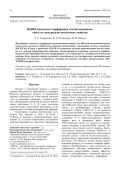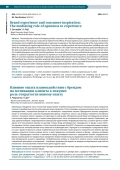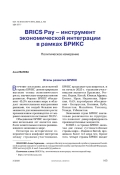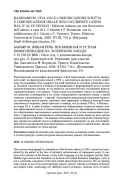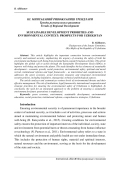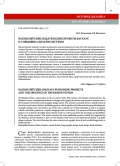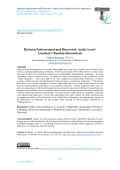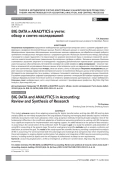Висмутовые комплексы порфиринов представляют интерес для ИК-люминесцентной диагностики рака, поскольку обнаружены довольно интенсивные эмиссионные полосы в диапазоне 800–920 нм. В связи с пандемией COVID-19 соединения висмута представляют также интерес и в лечении коронавирусной инфекции. Синтезированы висмутовые комплексы порфиринов различной пространственной конфигурации и исследован ряд их спектрально-оптических свойств. Было оценено влияние различных заместителей на спектральные характеристики методами исследования электронных спектров поглощения, спектров люминесценции, ИК-, 1H ЯМР-спектроскопии.
The introduction of new technologies provides consumers with additional shopping opportunities and allow them to test new products. The study was conducted to determine the effects of brand experience on customer inspiration and behavioral intention and to establish the mediating role of openness to experience. The theoretical framework of the study resides in the theory of marketing and cognitive appraisal theory. Convenience sampling method and structural equation modelling were used within the study. The population of the study consists of customers who order from the online takeaway portal yemeksepeti. com. The data were gathered using questionnaires collected online in June, 2023. A total of 416 valid responses were received. Smart PLS 4 statistical program was used to test the hypotheses. As a result of the tests, it was found that brand experience has a positive effect on customer inspiration and openness to experience. It was also determined that openness to experience has a positive effect on customer inspiration by partially mediating the positive effect between brand experience and inspiration. Furthermore, the hypothesis that customer inspiration positively affects behavioral intention was also confirmed. The research will contribute to expanding the literature on consumer inspiration and openness to experience. Among possible directions for further research is to test the proposed model in relating industries or using statistical data from other countries
В статье анализируются предпосылки создания BRICS Pay и политические аспекты её функционирования. Особое внимание уделяется снижению зависимости от доллара США и западной финансовой системы, укреплению политического влияния объединения БРИКС на мировой арене, формированию альтернативного финансового пространства.
Рецензируемая монография представляет собой переиздание этой книги, вышедшее в свет на французском языке в 1992 г., дополненное автором с учетом новейших исследований. Она содержит богатый материал по истории латинского языка Поздней Античности и Раннего Средневековья и формирования на его основе западно-романских языков, но не является систематическим изложением фактов, характеризующих этот процесс. Перед нами исследование одного из важнейших его аспектов: соотношения в эту эпоху литературного латинского языка, с одной стороны, и разговорного – с другой. Анализируя самые разные источники (трактаты, проповеди, жития святых, хроники, акты церковных соборов, в меньшей мере документы и надписи), автор приходит к выводу, что до конца VIII в., в Италии – до конца IX в. и даже позднее, сохранялось определенное единство между языком образованной элиты и языком плохо или вовсе не образованного населения, что обеспечивало вертикальную коммуникацию между этими социальными группами. Сохранялась и возможность коммуникации на одном языке во всем ареале романской части Европы. Эти выводы очень важны для осмысления социокультурных процессов данной эпохи и информативности дошедших до нас источников. Критически воспринимая некоторые выводы, содержащиеся в данной книге, авторы рецензии оценивают ее очень высоко.
The article aims to outline bloggings as a complex social phenomenon and identify the current role of blogs in virtual reality. The literature review revealed that the evolving paradigm of civilizational growth has led to a hybrid environment, which combines the aspects of physical world and virtual reality artefacts, resulting in a unique media landscape, significantly impacting sociocultural and communicative dynamics. However, the field lacks studies on typical features of blogosphere, such as its inherent openness, fostering informal communication, intention to both monetization and self-expression. To address the study’s objectives the research adopts an integrative interdisciplinary approach, including socio-philosophical and semiotic cultural studies, theory of computer communication, network and Internet discourse studies to use data from various fields of humanitarian knowledge. It is concluded that originally created as online diaries, currently blogs as a diverse media platform demonstrate several unique features, including high personalization, audience feedback capabilities, constant user engagement with various types of information (verbal, audial, visual). These characteristics positioned blogs as key contributors to the growth of virtual sociality, leading to the emergence of a new type of society characterized by heightened human sensory experiences and the development of new empathetic models and behavioral attitudes. A notable sign of these changes is that the audience’s attention has shifted from professional media institutions to individual bloggers, who are increasingly adopting media-like behaviors. The current research adopts an interdisciplinary approach, merging socio-philosophical and semiotic cultural studies, as well as with theory of computer communication, network and Internet discourse studies. It also employs methods of Internet linguistics and the principles of pragmalinguistics; the axiological method helps to identify value-based sociocultural guidelines within the framework of globalization.
Ushbu maqola atrof-muhit xavfsizligi va milliy xavfsizlik o’rtasidagi muhim bog’liqlikni ta’kidlab, atrof-muhit xavfsizligini va inson farovonligini inson faoliyati natijasida yuzaga kelishi mumkin bo’lgan zararlardan ta’minlashning dolzarbligini ta’kidlaydi. Maqolada farovonlikni yaxshilash va sayyorani himoya qilish uchun barqaror rivojlanish maqsadlari (SDG) orqali global harakatga chaqiriq ta’kidlangan. Tadqiqot barqaror rivojlanishning asosiy elementlari - iqtisodiy o’sish, ijtimoiy himoya, ekologik xavfsizlik, ma’naviy - axloqiy tiklanish, institutsional islohotlar va huquqiy asoslarni o’zaro bog’liq va bir-birini to’ldiruvchi sifatida belgilaydi.
Unda yashil iqtisodiyot, ijtimoiy himoya choralari va ekologik xavfsizlikning yaxlit siyosati, shu jumladan Qonunchilik, boshqaruv, texnik va biologik jihatlar ko’rib chiqiladi. Maqolada turli darajadagi ekologik tahdidlar va ularni samarali boshqarish tahlil qilinadi va tizimlashtiriladi. O’zbekistonning ekologik xavfsizligini ta’minlashda institutlar, huquqiy asoslar, xalqaro hamkorlik va strategik ustuvor yo’nalishlar muhim o’rin tutadi. Xulosa qilib aytganda, kelajak avlodlar uchun barqaror muhitni ta’minlash muammosiga kompleks yondashuv zarurligi ta’kidlangan.
The development of neurotechnologies is now at a critical point where direct readout and modulation of brain activity has passed from test studies to business applications, only to urgently require adequate legal and technological guarantees. The relevance of this study is prompted by the rapid development of the fifth generation brain-computer interface (BCI 5.0), a technology that provides unprecedented potential of direct access to neural processes while at the same time creating principally new threats to digital rights of individuals. The existing legal mechanisms have turned out to be inadequate for regulating altogether new risks of manipulating consciousness, unauthorized access to neural data and compromised cognitive autonomy. The study is focused on legal and technological mechanisms for protection of digital rights in the context of introducing the fifth generation neural interface technologies including analysis of regulatory gaps, technical vulnerabilities and possible security guarantees. Methodologically, the study is based on the multidisciplinary approach bringing together neuroscience, law and information technology, and on the comparative analysis of regulatory framework and inductive inference of specific regulatory mechanisms. The main hypothesis is: legacy regulatory mechanisms for data protection in biometric and telecommunication technologies are structurally inadequate for BCI 5.0 while digital rights could be protected only by a hybrid system combining special provisions with technological guarantees via mechanisms of computational law. The author puts forward a minimum set of viable security and confidentiality standards, comprehensive cryptography and blockchain-based ap plications, as well as detailed legislative advice for ethical and safe neurotechnological development with secure guarantees of fundamental human rights in the digital age. Findings of the study are of considerable practical value for legislators, those involved in the development of neurotechnologies, regulatory bodies and advocacy organizations by proposing specific evidence-based tools and mechanisms to strike an effective balance between the innovative development and the imperatives of protecting human dignity, mental autonomy and cognitive freedom.
Школа Баухаус занимает особое положение в художественной системе XX в. Как и русский конструктивизм, Баухаус стал базовой платформой для изменения графической программы и формирования дизайна XX столетия. Программа школы подразумевала радикальную реформу всей визуальной системы. Издательские проекты Баухауса, оказавшие принципиальное воздействие на последующее развитие графического дизайна, были задуманы как одна из форм представления новых художественных принципов, а также как поддержка незащищенного положения школы в быстро меняющейся социальной среде. Целью издательских проектов Баухауса было информирование о деятельности школы, а также представление смысла и возможностей новой художественной практики. В рамках данной работы рассматриваются основные издательские проекты, сформированные и поддержанные школой Баухаус. Особое внимание уделено серии книг Баухаус как важному прецеденту в сфере развития графического дизайна. Статья рассматривает содержательную основу и графическую форму такого публикационного проекта как Bauhausbücher.
В статье рассматривается влияние внешних факторов на образование, обусловленных особенностями сложившейся реальности BANI-мира. Признаки данного мира осмысливаются в контексте изменений в образовании как ответы на вызовы новой реальности. Раскрыта взаимосвязь изменений современной эпохи в виде вызовов для образования, педагогической практики обучения и воспитания, необходимости личностного развития обучающихся. Отмечена специфика современной практики, отвечающей требованиям новой реальности. Обозначены смыслы изменений в образовании новой реальности: модель «четырехмерного образования» в 21 веке, развитие личностного потенциала обучающегося как субъекта образовательного процесса, использование педагогического инструментария для развития личностного потенциала и создания личностно-развивающей образовательной среды. Также к этим смыслам относятся: воплощение идей персонализированного обучения, новая модель профессионализма педагога в изменяющихся условиях, развивающее управление в образовательных организациях и его инструментарий. Обозначен вклад ученых в разработку научно-теоретических ответов на новые вызовы современности к системе образования, педагогическому процессу воспитания и обучения, процессу личностного развития человека. Представлены результаты аналитической работы в виде положений и ключевых вопросов, интерпретирующих новые смыслы изменений в образовании.
Спорт является неотъемлемой частью воспитательной работы в российских вузах, прививая необходимые духовные и нравственные ценности студентам и предоставляя молодым людям возможность участвовать в социально полезных практиках, направленных на развитие спорта и формирование культуры здорового образа жизни. Актуальность деятельности вуза в вопросе реализации спортивно-оздоровительного компонента внеучебной деятельности и воспитательной работы подчеркивается как государством, так и обществом. Данное направление работы включает в себя привитие обучающимся ценностей здорового образа жизни как необходимого условия для развития российского общества, а также создание всех необходимых условий для развития физической культуры и спорта. Цель данной статьи – проанализировать эффективность принятых Южным федеральным университетом мер и используемых им механизмов для достижения поставленных перед вузами целей в сфере массового спорта.
Методы. Положения статьи основываются на результатах социологических исследований, проведенных в 2023 и 2024 годах методом анкетного опроса: ежегодный мониторинг «Портрет студента ЮФУ» и исследование, проведенное на платформе «Неравнодушный человек». Всего в рамках двух исследований было опрошено 4350 обучающихся Южного федерального университета.
Результаты исследования. Спортивная деятельность – значимый компонент внеучебной работы образовательной организации. Несмотря на включенность большого количества студентов ЮФУ в спортивную деятельность вуза, выявлены перспективы развития данного направления. С одной стороны, необходима работа по увеличению числа женской группы обучающихся, занимающихся активными видами спорта. С другой, важно создавать и развивать формы пассивного участия всех студентов в спортивных мероприятиях.
Material-based interpretations of everyday undertakings have long been of interest to the French social sciences, including anthropology and history. André Leroi-Gourhan (1911-1986) follows to some extend this trend, insofar as his pioneering contributions to ethnographic and prehistoric technology – from the “elementary forms of human activity,” to studies of stone tool manufacture, to the formulation of the “chaîne opératoire” – shed much light on the more tangible and infrastructural dimensions of human existence. At the same time, his predominantly idealist recourse to evolutionary “tendencies,” “vital thrusts” (élan vital), and suchlike metaphysical notions rather held him at bay from would-be historical and dialectical understandings of primitive socio-economic formations – and this, despite his ready access to and close acquaintance with the professional literature from the other side of the Iron Curtain. Hence the paradox, as outlined here, of Leroi-Gourhan’s distant attitude towards the conceptual (historical-materialist) substrate of Russian-cum-Soviet archaeology, on whose practical achievements he nonetheless remained well-informed and appreciative. In turn, this ambivalence may partly explain the rather superficial and incomplete perception of Leroi-Gourhan’s works within Soviet archaeology and anthropology, limited to his publications on Prehistoric art and religion while ignoring his broad-ranging contributions to “anthropogenesis.”
Актуальность исследования определяется необходимостью адаптации бухгалтерского учета к условиям цифровой трансформации и внедрения технологий больших данных. Понятия «большие данные» и «аналитика больших данных» стали общепринятыми терминами, обозначающими значительные массивы информации, для обработки которой требуется применение инновационных методов анализа и управления данными. Используя аналитические методы, бухгалтеры сталкиваются с рядом трудностей, что ограничивает их широкое применение. Одна из основных сложностей заключается в недостаточной адаптации традиционных бухгалтерских платформ к работе с большими данными. Компании сталкиваются с высокими затратами на их внедрение и поддержку. Дополнительным препятствием к распространению аналитики данных в бухгалтерском учете является консерватизм самой профессии.
Цель исследования — изучение проблем и возможностей использования больших данных в бухгалтерском учете на современном этапе. Для достижения этой цели применялись общенаучные методы, такие как анализ, синтез и абстракция.
Результаты исследования расширяют научную литературу, предоставляя всесторонний анализ по применению больших данных в бухгалтерском учете. Исследуются как преимущества, так и вызовы, с которыми сталкиваются компании при внедрении данных технологий. В условиях продолжающейся цифровой трансформации полное принятие и интеграция BDA требуют преодоления существующих барьеров, включая технические аспекты и готовность профессионалов адаптироваться к новым требованиям.
